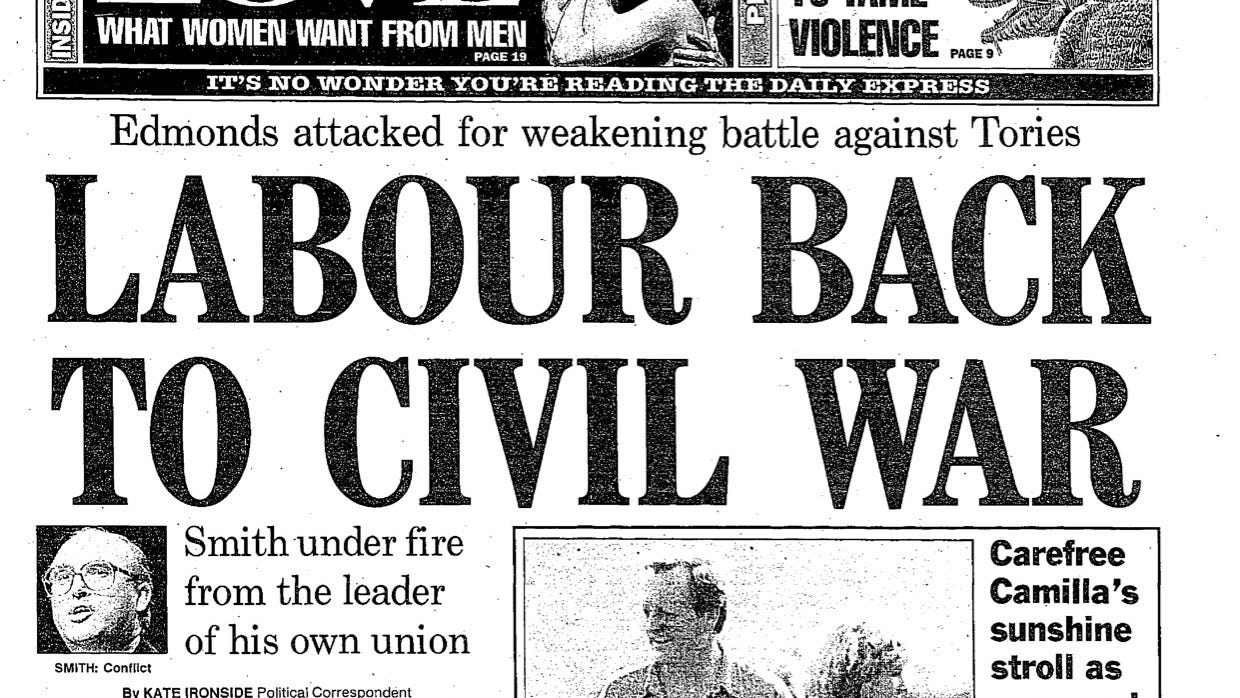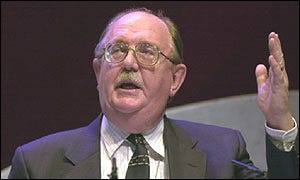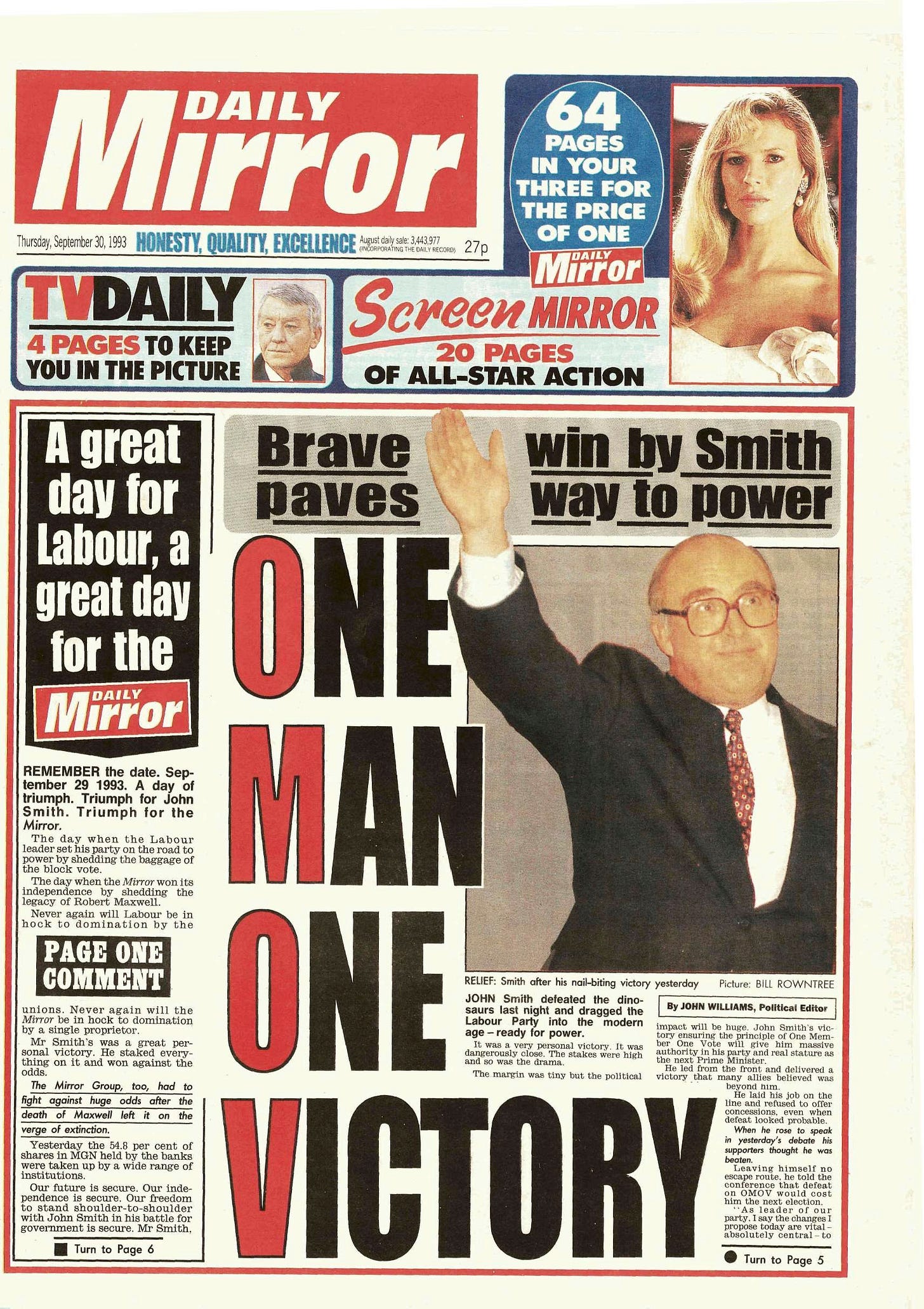1993 conference part I: The unions
The Labour Party resets its relationship with the trade unions in a vote that put Smith’s leadership on the block.
In a smoky bar in 1899, a group of railway workers gathered excitedly in a pub. In the 1894 election, three MPs, led by Scottish union activist Keir Hardie, had joined the House of Commons as representatives of the independent labour movement. The workers sensed an opportunity to challenge the political establishment.
These workers, the Doncaster branch of the Amalgamated Society of Railway Servants, put a motion to those in attendance. The proposal would unite cooperatives, trade unions, socialists, and other labour organisations behind an effort to increase the number of working-class MPs in the next parliament. A year after that meeting, the Labour Party was founded, formally uniting the coalition at a conference in London, with Keir Hardie as its first leader.
An ailing relationship
The Labour Party was born from the trade union movement. But by the early 1990s, there were good reasons to re-evaluate the party’s relationship with its progenitor. The share of British workers that were union members had fallen to 19 percent in 1992, less than half of which voted Labour. Yet, within the party, unions still held expansive powers over policy, leadership, and candidate selection.
Unions held a 70 percent block vote at the party conference. They held 40 percent of the electoral college vote for the Labour leadership. But their influence over candidate selection was even more penetrating.
Union-backed candidates received sponsorship in the form of additional funding and access to a pool of campaign staff, volunteers, office facilities, and training. Trade unions also had a direct say in the candidate selection process. Since 1987, affiliated organisations, including unions, held up to 40 percent of the constituency electoral college vote to finalise candidates and had a say in appointing the constituency executives that determined the candidate shortlists.
While party members had to attend the selection meeting from beginning to end in order to vote in candidate selection, on the basis that only those that had heard the candidates speak could make an informed decision, union leaders received a ballot paper without conditions. Bosses didn’t even need to consult members before voting.
The result of union hands on the scales of candidate selection was apparent after the 1992 general election. Of the 173 candidates unions sponsored, 143 were elected, a success rate of 83 percent (among unsponsored candidates, the success rate was 28 percent). Unions now sponsored half of all MPs in the Parliamentary Labour Party.
Union’s imperium over the candidate selection process awarded them significant clout in the party. Candidates placed in safe seats could sit in parliament for an entire political career and play a decisive role in shaping the party’s direction. David Ward, John Smith’s head of policy, told IFTC, “it was like a patronage system they had, putting their favoured sons and daughters into certain seats where they had a decisive influence.”
Unions also used their affiliations with the Labour Party as a way to manage personnel. “Secretary Generals could advance a rising star or remove a possible rival by placing them in seats effectively under their union’s control,” Ward said.
In the 1950s and 1960s, unions had fostered working-class representation in parliament and provided greater socioeconomic diversity among candidates. But even this benefit had faded by 1992. Between 1950 and 1966, 82-85 percent of union-backed candidates had come from a working-class occupational background. In 1992, it was just 25-28 percent—a greater share than non-sponsored candidates, but only marginally.
Not a divorce, but some space
The union link wasn’t the electoral liability it had once been. Thatcher’s legislative assault on union powers throughout the 1980s had slashed the share of voters who thought unions held too much power. But Smith was devoted to strengthening democracy within the party.
Smith talked the talk. He frequently accused the Conservative government of being more concerned with power than democracy and had already outlined his sweeping vision for constitutional reform and a strengthened British democracy. Taking on the union influence showed he was committed to democratic principles, even when it wasn’t politically expedient. He was walking the walk.
Smith found widespread agreement over dissolving the union block vote and adjusting the electoral college composition for selecting a Labour leader. Limiting unions’ role in candidate selection, however, stirred bitter, albeit highly contained, conflict.
Smith could have settled for limited reform of the block vote and leadership selection process, thereby avoiding a raft of negative headlines and political in-fighting. Devoting political capital to modernizing the candidate selection process at a time when the Conservative Party was vulnerable over Black Wednesday, its mishandling of the economy, and internal divisions over Maastricht might have seemed like ill-timed naval gazing. It was a bold move from Smith, but winning a difficult internal battle would have bolstered his leadership credentials.
Modernisers like Smith, Tony Blair, and Gordon Brown saw Labour’s future as a highly participatory party with a growing, diverse membership. They supported a move to a one member, one vote (OMOV) system for candidate selection, where all party members received an equal say in who would run for parliament in their constituency.
A messy domestic row
Neil Kinnock’s team had advised John Smith to tackle the union relationship in 1992, but Smith couldn’t rely on union promises given to Kinnock. He’d have to secure his own support for a deal, and for that, he needed more time. The union block vote at the Labour Party conference would also fall from 90 to 70 percent in 1993, weakening possible union opposition and boosting OMOV’s chances of success.
The major unions, including Smith’s own GMB and the Transport and General Workers Union (TGWU), were determined in their opposition. Trade unions provided two-thirds of all Labour Party funding, including 75 percent of the 1992 general election campaign costs. For this steady flow of revenue, they argued, they should have a voice in candidate selection.
They also insisted the union link gave Labour access to a large pool of potential members. This claim is more dubious. Party membership had been declining since the 1950s, suggesting this pool was dwindling and the Labour’s future members lay outside the trade union movement.
With the large unions against OMOV, reform depended on support from the mid-size unions. In July, Smith called union representatives to Westminster and, after five hours of negotiations, Smith thought he had achieved a compromise.
The block vote would fall to 50 percent after party membership reached 300,000. In leadership elections, the electoral college would be split evenly between unions, MPs and MEPs, and party members, replacing the 40/30/30 split, and only Labour-supporting union members could vote. Candidate selection would be decided by OMOV, but union members could join the party at a subsidised rate of £3 and participate in the vote as full party members.
Even with the compromises, the major unions were unmoving and heading into the September party conference in Brighton, the vote looked lost. In a speech at the Trades Union Congress just weeks before conference opened, Smith reiterated the need for strong unions, promised to enact the Maastricht Treaty’s social chapter, committed to implementing a Charter of Rights for workers, and reaffirmed Labour’s commitment to full employment.
His promises gave union bosses much of what they would want from a Labour government, but it also reminded union bosses that there was nowhere else to go. The party was still the natural home of the labour movement. He hoped this would be enough to buoy his support at the conference vote.
Smith’s head on the block
Going into the conference, Smith’s chances of victory were still too close to call and opponents now claimed to have a majority in the constituency parties as well as the unions. Smith attached the implementation of all-women shortlists to the package to secure the necessary Constituency Labour Party votes.
Losing the OMOV fight would shatter Smith’s authority in the party. He was keenly aware that it might result in his resignation. “There was a plan B,” David Ward told IFTC. “If he lost, he would then have asked for a vote of confidence.” He would likely have won a no-confidence vote, but it was a gamble and he would have emerged weaker from the ordeal.
On September 29th, as the union delegates submitted their votes, it was touch and go. The National Communications Union (NCU) leadership rejected last-minute appeals to fall in line behind Smith. Sensing the vote was slipping out of reach, Murray Elder suggested Smith ask John Prescott to deliver a rallying speech. Prescott had been an earlier critic of OMOV, but he trusted Smith and knew that a victory over OMOV was crucial for his leadership.
Prescott took to the podium with only rough notes and delivered a mic-dropping, rousing speech that conveyed Smith’s line in passionate, but no-frills language. He reassured delegates that the party had no intention of completely severing its historic link with the unions and stressed the need to back Smith’s leadership. He received a spontaneous standing ovation for his efforts.
“I had to turn it into something which was about emotion, that they would feel safe about going back to their constituencies.”—John Prescott.
The motion passed by 47 percent to 44. The Manufacturing Science Finance (MSF) union abstained from using their 4 percent block vote so as not to sink the all-women shortlists tied to the package, turning a narrow defeat into a narrow victory for Smith. Without Prescott’s speech, the tight victory may have looked like the unions had held their noses and voted with Smith to avoid a possible change in leader1. But Prescott’s speech reframed the vote into a ringing endorsement of Smith and his vision for the party.
The vote showed the party and the British public that Smith could turn his rhetoric and principles into meaningful reform. At considerable personal risk, he had faced down bitter opposition with the comportment and strength of will of a political leader. Party membership increased in the years immediately following the vote and, while reforming candidate selection may not have been an electoral winner with the wider public, Smith successfully strengthened party democracy and paved the way for Blair to go further.
Before you go…
Friend of IFTC John Curtice broke down this week’s leadership poll among Conservative Party members in The Times and explained what it means for Truss and Sunak’s chances.
And Cenk Uyghur interviewed Anthony Barnett on the Young Turks on the state of the progressive movement in the US.
The conference also passed an anti-OMOV resolution that would restore the block vote in candidate selection by 0.2 percent, but Smith’s vote took precedent and the resolution was ignored.








